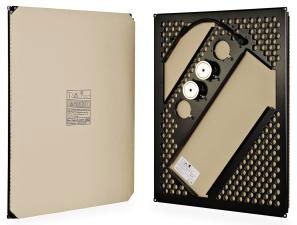Test Report: Triad Speakers Page 2

SETUP
Let's get the easy stuff out of the way first. The Triad OnWall Mini LCR 3.0 couldn't be simpler to install. Plop it on a table or hang it on the wall using the supplied bracket, then connect the three internal speakers. Done. I didn't cut the two InWall SlimSub/4s into my walls, but I got the same acoustical effect by placing them flat on the floor in the front left and right corners of my room. To power the dual SlimSubs, Triad supplied a single RackAmp 300 DSP, a switching-type amplifi er rated at 300 watts. The remote control lets you select from five preset EQ modes. A single RackAmp 300 DSP can power one or two SlimSubs.
In order to try the Designer Series as surrounds and as main left/right speakers in a stereo system, I built a couple of movable fake walls to hold them. The walls used 2x4 construction with standard 16-inch-on-center stud spacing and 1/2-inch drywall. Despite my considerable drywalling experience, installing the Designer Series speakers was complicated and time-consuming. The foam panel has to be painted with PVAC-based drywall primer, wired using a pair of crimp connections, attached to the wall with four medium-density fiberboard brackets, and then mudded in. But you can't just mud it in at the edges like you might with a drywall patch. You have to skim-coat it with 1/6 inch of drywall compound. The installation came out fine, but I sure felt like I had to jump through a lot of hoops.
The NXT exciters in the Designer Series can't handle deep bass or lots of power, so Triad includes the HPF2 inline high-pass filter/current limiter. The filter connects between your amp and the speakers, and is small enough to disappear into the clutter behind your equipment rack.
- Log in or register to post comments



































































